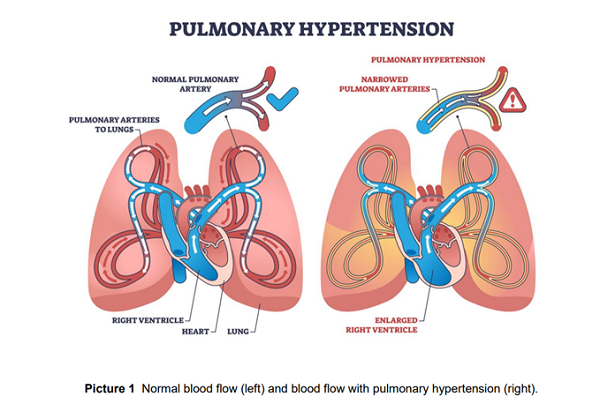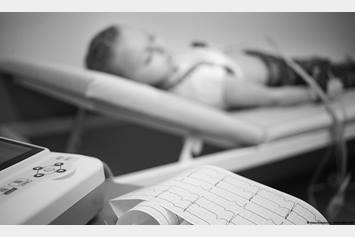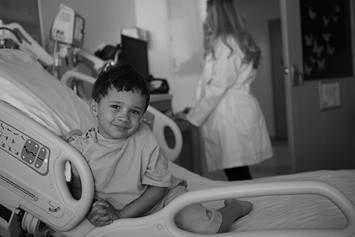Pulmonary Hypertension
Pulmonary hypertension (PH) is high blood pressure in the arteries of the lungs. This makes it harder for blood to flow to the lungs.
What Is Pulmonary Hypertension?
Pulmonary hypertension is a rare condition when the blood pressure in the lungs (pulmonary artery system) is higher than normal. The Pulmonary Hypertension Program at Nationwide Children's Hospital is dedicated to delivering top-quality care and advanced therapy to patients with this diagnosis.
Normal blood pressure in the lungs is much lower and much more difficult to measure compared to the body's blood pressure measured in the arm. Normal blood pressure in the lungs is 15 -25 mmHg, or about 1/5th the body’s blood pressure.
Pulmonary hypertension (PH) is a disease affecting the blood vessels in the lungs. The blood vessels that carry blood to the lungs come from the right side of the heart (shown in blue). In pulmonary hypertension, the vessels are thickened and constricted, creating high pressure in the lungs. This creates extra work for the right side of the heart and it becomes harder to pump blood to the lungs. Over time, this can cause the right side of the heart to become enlarged and weak, leading to heart failure.

What Causes Pulmonary Hypertension?
There are many conditions that can cause pulmonary hypertension (PH). These can be present as a newborn baby or develop later in life. The following are some of the conditions with examples listed.
| Causes | What that means |
| Congenital heart disease (CHD) | Born with a heart condition like atrial septal defect, ventricle septal defect or an unrepaired heart condition |
| Persistent pulmonary hypertension (PPHN) | The pressure in a newborn baby’s lungs doesn’t change after they are born. This makes it hard for the baby to breathe. |
| Lung disease or trouble (disordered) breathing |
Abnormal lungs or difficulty breathing
|
| Pulmonary vein stenosis | Blood vessels that carry blood from the lungs back to the heart are narrow |
| Genetic or inherited from family |
PH caused by a genetic change
|
| Unknown causes |
Patient does not fit other causes of PH
|
What Are the Signs and Symptoms of Pulmonary Hypertension?
The signs and symptoms of pulmonary hypertension vary based on age. Some of them include:
- Chest pain
- Dizziness
- Fainting (syncope)
- Fatigue
- Frequent stopping with walking
- Rapid pulse or palpitations of the heart
- Shortness of breath
- Unable to keep up with peers
- Unable to gain weight
How Is Pulmonary Hypertension Tested, Monitored and Diagnosed?
There are many tests that can be used to help diagnose pulmonary hypertension. Some of the more common ones the PH team may recommend initially are:
| Test | Purpose of Test |
|
Blood work |
|
|
Chest CT (computed tomography) |
|
| Chest X-ray |
|
| Echocardiogram – ultrasound of heart |
|
Additional testing may include:
| Test | Purpose of Test |
| ENT/Pulmonary bronchoscopy |
Procedure that requires sedation to look at airway with a camera
|
| Heart (cardiac) catheterization |
An invasive procedure performed in the catheterization lab (specialized operating room). This test needs sedation.
|
| Lung perfusion scan |
Test done in radiology with IV contrast
|
| Sleep study |
Overnight hospital monitoring of breathing and oxygen saturations
|
How Is Pulmonary Hypertension Treated?
Nationwide Children's offers a team of experts focused on treating children with pulmonary hypertension. Finding PH early is very important. There is no cure for PH, but medicines and breathing therapies can help keep the heart and lungs as healthy as possible.
- Medicine – Used to help lower blood pressure in the lungs. These medicines may be given:
- By mouth (oral)
- Breathed in (inhaled) directly to the lungs
- Through a feeding tube
- Into the skin by a special pump
- Nitric oxide – Breathed into the lungs to relax the blood vessels. This may be needed if your child is in the intensive care unit (ICU). It’s not a treatment you can do at home.
- Oxygen therapy – Helps relax the blood vessels in the lungs so that may help improve oxygen saturations and fatigue
Other treatments may include:
- Avoiding lung damage: preventing aspiration and infection
- Breathing machine (ventilator) – Used to help with breathing by wearing a mask on the face or breathing into a tube in the airway.
- Diuretics – Medicines that help your child pee (urinate) extra fluid that’s in their body.
- Nutrition – Your child needs the right number of calories and protein to help their lungs grow and heal.
When Should I Call the Doctor?
Call your child’s heart doctor (cardiologist) if they have:
- Trouble breathing
- Irregular heart rate
- Fainting
- Chest pain
- Rapid heart beat
- Poor appetite
When to Call 911
Call 911 for emergency help if your child has any of these signs:
- Has a seizure
- Is gasping, wheezing or grunting
- Coughs up blood
- Skin color changes to grayish blue or is very pale
- Hard to wake up (lethargic), acts confused or doesn’t know what they’re doing
Why Choose Nationwide Children's?
Nationwide Children's is one of the few program in the U.S. that offers a pediatric Pulmonary Hypertension Program. As the leader in pediatric care, we also offer all cardiology services, cardiothoracic surgery, and everything else you would expect to find at a nationally-renowned heart center. Whether your child is newly diagnosed with PH, or you have been living with a congenital heart condition for many years, our pediatric experts offer specialized patient care and support for the entire family. Nationwide Children's Hospital is ranked by U.S. News & World Report for Cardiology and Heart Surgery.
Leading the Way to New Treatments and Outcomes Through Clinical Research
Clinical care and research work together. This helps scientists and doctors to find new treatments and therapies. Clinical studies (also called clinical trials) will continue to become more common in daily care at Nationwide Children's. Clinical studies help doctors learn more about conditions and treatment.
This means you might hear about a clinical study that your child might be able to join. This does not mean that your child has to join a study. You always have the choice about whether or not to join a study.



